The Anti-slip Regulation System (ASR) is developed on the basis of the Antilock Braking System (ABS). After adding the engine output torque adjustment function and the drive wheel brake pressure adjustment function to the ABS-equipped car, the wheel speed sensor and pressure regulator used by the ABS can all be used by the ASR [1]. ASR and ABS are similar in algorithm, and many program modules can be used in common. Therefore, in practical applications, the two can be integrated into one controller to form an ABS/ASR integrated system.
1 Introduction to the car ABS/ASR integrated control system
Through the modification of the hydraulic brake system of the Jetta GTX test vehicle, the hydraulic actuator of ABS/ASR integrated system that can independently adjust the pressure of four wheel cylinders is realized [2]. On this basis, a car ABS/ASR integrated control system was developed, which mainly consisted of three parts: control system ECU, sensor and actuator. Figure 1 is a schematic diagram of the car ABS/ASR integrated control system. 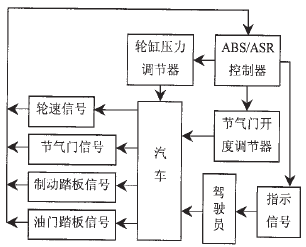
Figure 1 ABS / ASR integrated control system block diagram
This article refers to the address: http://
When the car is driving normally, the ECU of the ABS/ASR integrated control system collects and processes the sensor signals in real time, and according to the information provided, selects different control methods to control the car. The control method includes a brake torque control mode for adjusting the wheel-cylinder pressure and a throttle opening control mode for adjusting the engine output torque. The realization of the functions of the ABS and ASR subsystems is the result of proper combination and reasonable control of the above two control modes.
2 ABS/ASR integrated control system ECU
2.1 Selection of MCU
The MCU is the core of the ABS/ASR integrated control system. It is responsible for data acquisition and processing, all logic operations, and final control implementation. Taking into account the integrated control system's computing power, storage space, I / O interface requirements and the subsequent integration of other systems, the powerful Motorola's next-generation HSC12 series 16-bit MCU - MC9S12DP256 - was chosen.
It has strong computing power, rich I/O interface and ample storage space. With STAR12 CPU, the core computing power can reach 50MHz, and the bus speed can reach 25MHz. With the optimized instruction set, the operation speed of the instruction is greatly improved. The core frequency of the MCU can be easily selected by the on-chip PLL function regardless of the external crystal frequency. The chip integrates 256K FLASH, 12K RAM and 4K EEPROM, which can fully meet the storage requirements of the program. It has a rich set of I/O interfaces, including two asynchronous serial communication interfaces (SCI), three synchronous serial communication interfaces (SPI), eight-channel input capture/output comparison (IC/OC), sixteen 10-bits. A/D interface, eight 8-bit PWM, twenty-nine independent digital I/O interfaces, twenty digital I/O interfaces with interrupt and wake-up functions, five CAN bus interfaces, one IIC bus interface, one BDLC (J1850) Interface [3].
The MCU has four input captures (with a hold buffer). The independent ECT capture clock can be used to calculate the cycle between two pulses. It is ideal for wheel speed acquisition of four wheels, greatly improving the efficiency of the MCU. .
2.2 ECU hardware circuit design
The peripheral circuit of the MCU adopts the modular design idea, that is, the electronic control unit is divided into different modules, and the mature and fixed modules are formed into a single circuit board. The modules with larger changes during the research process constitute another single circuit board. The board communicates with the board through the I/O expansion slot. This design method facilitates the maintenance and expansion of the system during the test. For example, when the circuit needs to be changed or expanded, there is no need to redesign the entire circuit, only need to change or add on the corresponding module; the modular design also It has better electrical characteristics. For example, the driver module is a relatively large interference source. It has a great influence on the A/D conversion and MCU work. It can be placed on different circuit boards and the signal lines can be isolated.
According to the characteristics of the ABS/ASR integrated control system, the entire electronic control unit is divided into an A board and a B board, and the two circuit boards are connected by an I/O bus expansion slot.
The A board mainly includes the main control chip MC9S12DP256 and its minimum system peripheral circuit, communication interface circuit and data acquisition circuit, as shown in Figure 2. 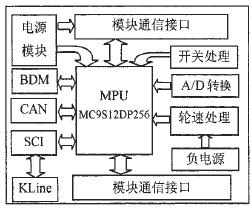
Figure 2 A board circuit structure diagram
The minimum system peripheral circuit of MC9S12DP256 includes power supply module, peripheral reset circuit, clock crystal oscillator circuit, working mode selection and so on.
The communication interface circuit includes a BDM interface. Two-way SCI serial communication interface circuit, one of which is connected to the fault diagnosis driver chip MC33199 through hardware jumper, and uses the PCA82C250 driver chip to lead out two CAN communication nodes, which are reserved for the integrated control system.
The A board also includes digital, analog and switching quantity acquisition processing circuits in the ECU, which mainly include four wheel speed signals, a throttle opening signal, an accelerator opening signal, a high pressure accumulator pressure sensor signal, and a brake pedal. Switching signals, etc.
The B board mainly includes an actuator driving circuit and a switching signal processing circuit, as shown in FIG. 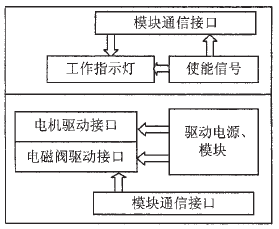
Figure 3 Schematic diagram of B board circuit structure
The system-driven actuators mainly include four normally open inlet valves for ABS pressure regulators, four normally closed oil solenoid valves, four ASR solenoid valves and one ABS motor.
The enable signals for the ABS and ASR subsystems and the associated circuitry for the operating indicator portion are also placed on the board.
2.3 ECU control software design
The ABS and ASR subsystems in the ABS/ASR integrated control system are inherently complex control systems. The integration of the software system is not simply to superimpose the ABS and ASR control systems, but to integrate them organically, taking into account the real-time and reliability of the software.
The control software of the integrated control system is mainly composed of the system initialization module, the startup self-test module, the main control module, the brake pedal interrupt service program module, etc. The overall block diagram is shown in Figure 4. 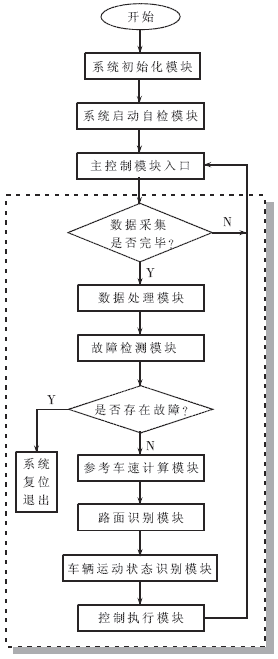
Figure 4 ABS/ASR integrated control system software block diagram
The system initialization module initializes the system when the system is powered on. The initialization includes the internal clock of the MCU, each port setting, serial communication interface, analog and digital channels, watchdog timer, system variables, etc., to ensure the normal operation of the MCU. It also includes resetting the actuators of the integrated system to ensure safe driving of the vehicle.
Starting the self-test module is to statically detect the key software and hardware parts after the system is initialized to determine whether the software and hardware work of the system is normal. If a fault is found in the integrated control system, the fault warning light will illuminate continuously.
The main control module is the main control program of the ABS/ASR integrated control system, as shown in the dotted line box in Figure 4. The main control module performs a fixed cycle of 20ms through the real-time interrupt RTI, and continuously calls the fault diagnosis module, the data processing module, the reference vehicle speed calculation module, the road surface recognition module and the vehicle motion state recognition module to perform the vehicle motion state and the external environment judgment in real time. Then, according to the current running state of the vehicle, the logic execution threshold control of the ABS or the ASR is respectively performed by the control execution module.
The brake pedal interrupt service routine is designed in consideration of the emergency braking needs of the driver's braking action and ASR brake intervention control. When the brake pedal trigger is interrupted, enter the brake pedal interrupt service routine. If the integrated control system is in ASR mode, immediately exit the current control, reset the actuator module, resume the normal brake mode, and do not interfere with the driver. The braking action ensures the safety of the vehicle.
3 test results and analysis
Using the developed acquisition system [4] and the ABS/ASR integrated control system designed in this paper, the typical working conditions ABS and ASR tests were carried out on the Jetta GTX test vehicle to verify its control effect.
The ABS test was carried out on a dry asphalt pavement with a braking initial speed of 50 km/h. Figure 5 shows the linear braking process with ABS control. The figure shows the process of the vehicle's left front wheel speed change. The vehicle speed can be better approached during the whole braking process, and the wheel slip rate is also controlled in an ideal area to ensure the vehicle braking process. Directional stability. 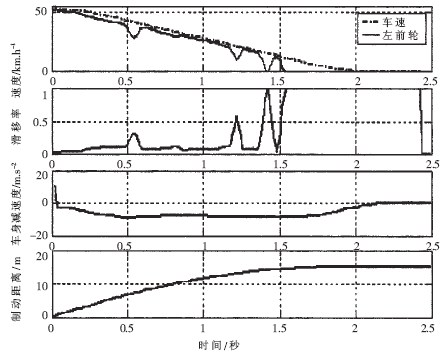
Figure 5 Linear brake with ABS control, dry road, initial velocity 50km/h
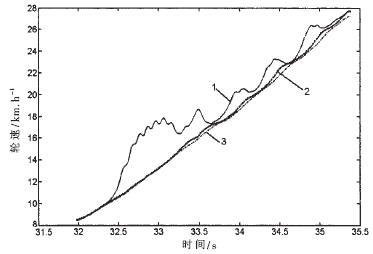
Fig. 6 Comparison of driving wheel speeds on the left and right sides of ASR off road
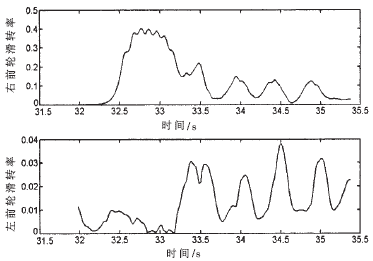
Fig. 7 Comparison of driving wheel slip ratios on the left and right sides of ASR on the pavement
The ASR test selects the starting step of the first gear on the road surface, and the right wheel is on the low adhesion coefficient road surface. Figure 6 is a comparison of the rotational speeds of the left and right drive wheels during the starting process, where curve 1 is the right drive wheel speed, curve 3 is the left drive wheel speed, and curve 2 is the non-drive wheel speed, which can be approximated as the body speed. It can be seen that at the beginning of the start, the right drive wheel has a significant slip, and the ASR starts to adjust around 33.5 seconds, and the wheel slip is significantly improved. Fig. 7 is a curve showing the change of the slip ratio of the driving wheels on the left and right sides during the starting process, which more obviously reflects that the slip ratio of the right sliding drive wheel is controlled within a relatively ideal range after the ASR control. At the same time, the slip rate of the left drive wheel increased slightly due to the influence of the brake intervention.
Through the actual vehicle test, it shows that the ABS and ASR functions in the ABS/ASR integrated control system have achieved ideal control effects, which creates conditions for the integration of other chassis active safety control systems.
references
1 Akihiko Sekiguchi, Toshifumi Maechara. ASR Built in an Add-On ABS[J]. SAE Technical
Paper Series 930506, 1993
2 Cui Haifeng. ABSASR Integrated Hydraulic System with Active Adjustment of Four Wheel Cylinder Pressures[J]. Hydraulics & Pneumatics, 2005(4)
3 MC9S12DP256B Device User's Guide V02.11.Motorola Inc. USA, 2002
4 Shi Kaibin. Automotive ABS/ASR/ACC integrated data acquisition system development and ABS control logic research: [Master's thesis].
Beijing: Beijing Institute of Technology, 2003
Each IGET XXL includes a 7ml e-liquid and comes in a range of tasty flavours. Grape, mixed berry, mango, mojito lime, passionfruit mango, peach ice and more!
The IGET XXL is a device for leisure vaping, 1800 puffs made of light SS material & providing comfortable hand feeling. With amazing flavour and a large capacity, the IGET XXL will be there for whenever you need it.
Description:
The IGET XXL is a device for leisure vaping, 1800 puff made of light SS material & providing comfortable hand feeling. With amazing flavour and a large capacity, the IGET XXL will be there for whenever you need it.
Features:
- 1 x IGET XXL disposable device
- Pre-Filled: 7mL Salt Nic
- NET WEIGHT: 35g
- Pre-charged, Simply puff on the device to activate
- Salt Nic.: 5%,( 1923247,50MG) Salt Nic inside for an accurate cigarette-style throat hit
- Up to 1800+ Puffs per disposable
- Compact, Light, and Portable
Products name IGET XXL
Warranty 100% AuthenticPod capacity 5%+7ML+1800PUFFS
Size 19*19*114mm
Weight 60g
Battery capacity 950mAh
Power 7-12W
Voltage 3.7V
IGET VAPE, IGET XXL ,IGET XXL VAPE
Shenzhen Essenvape Technology Co., Ltd. , https://www.essenvape.com
